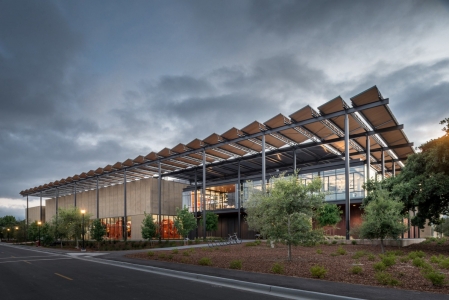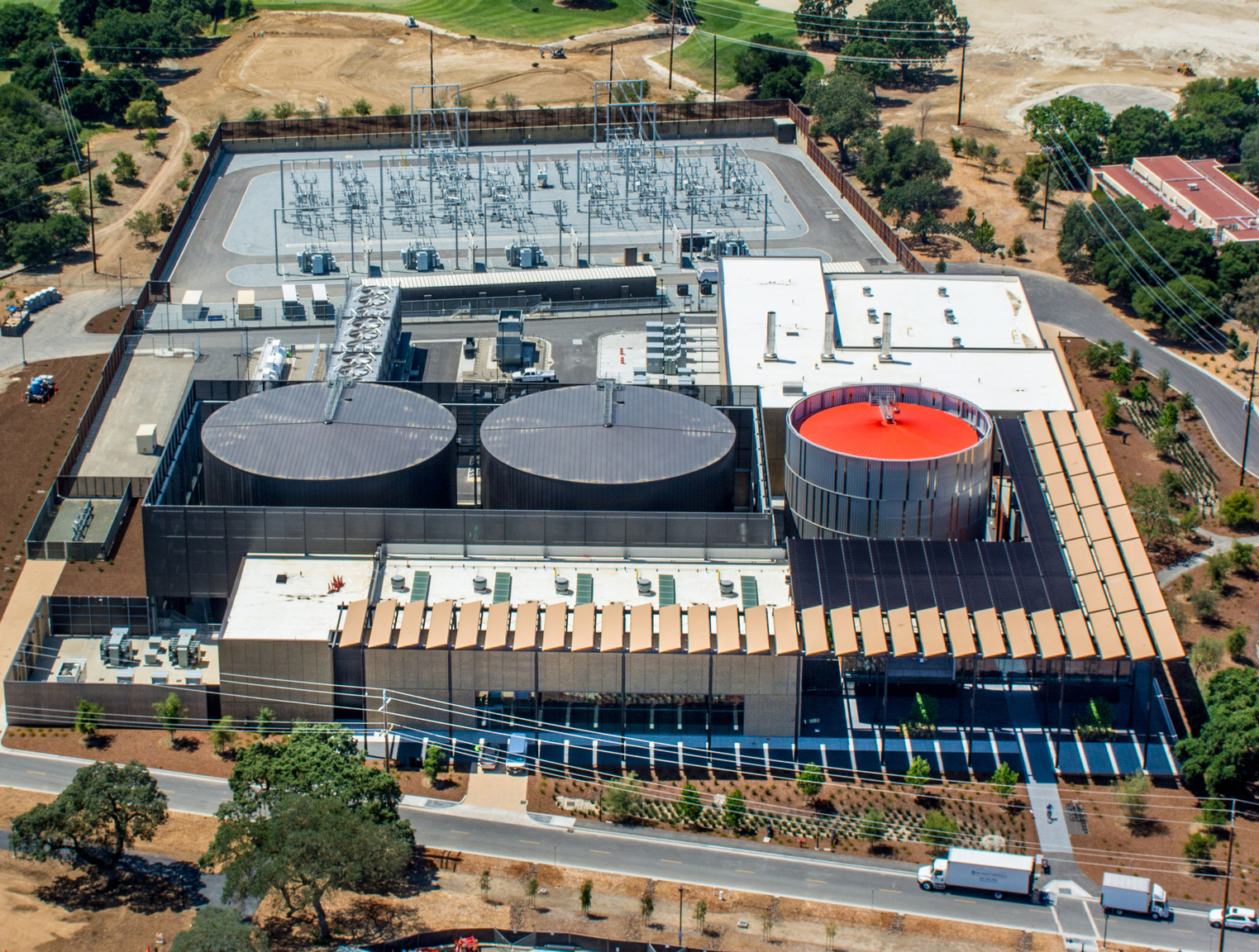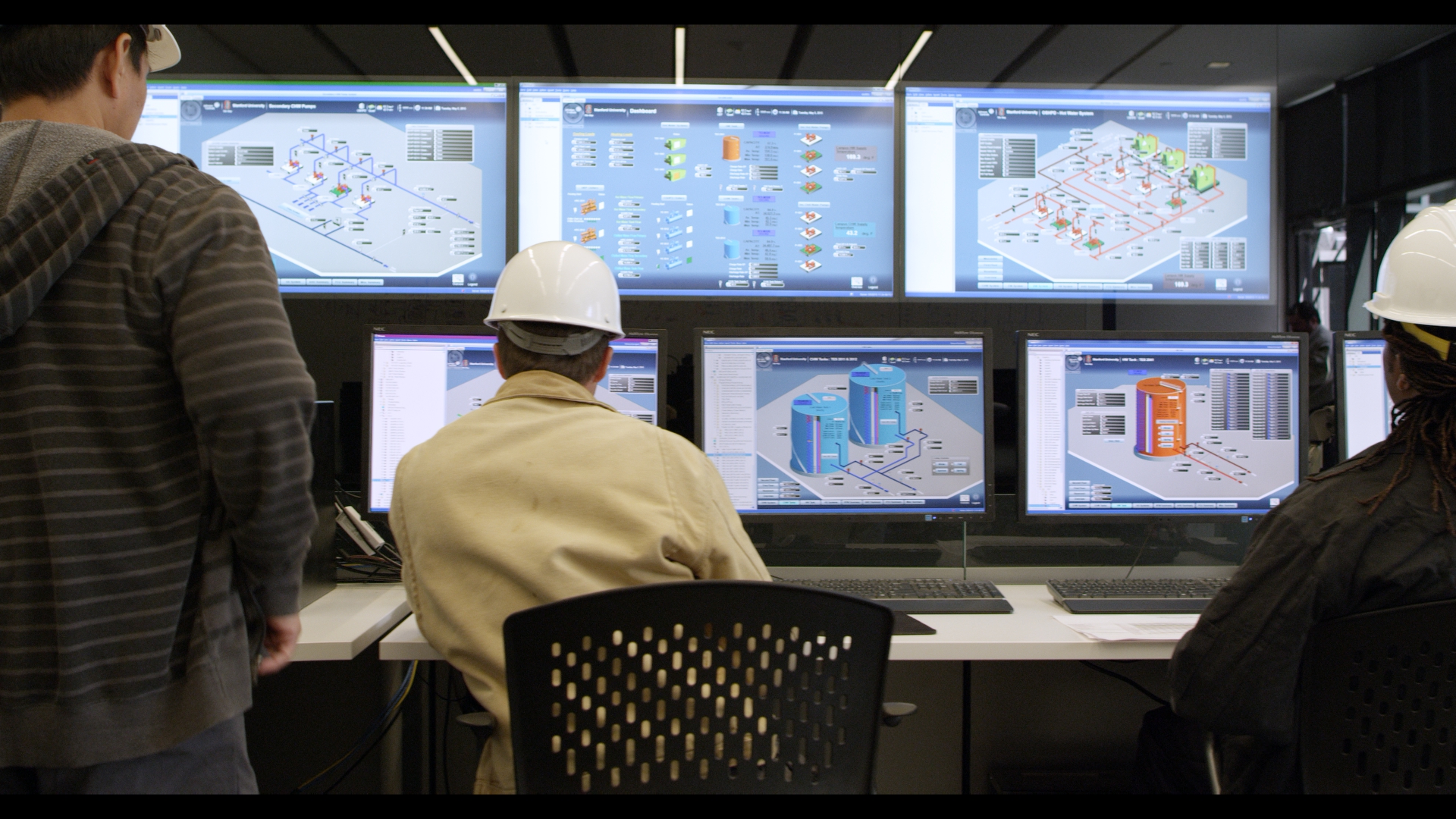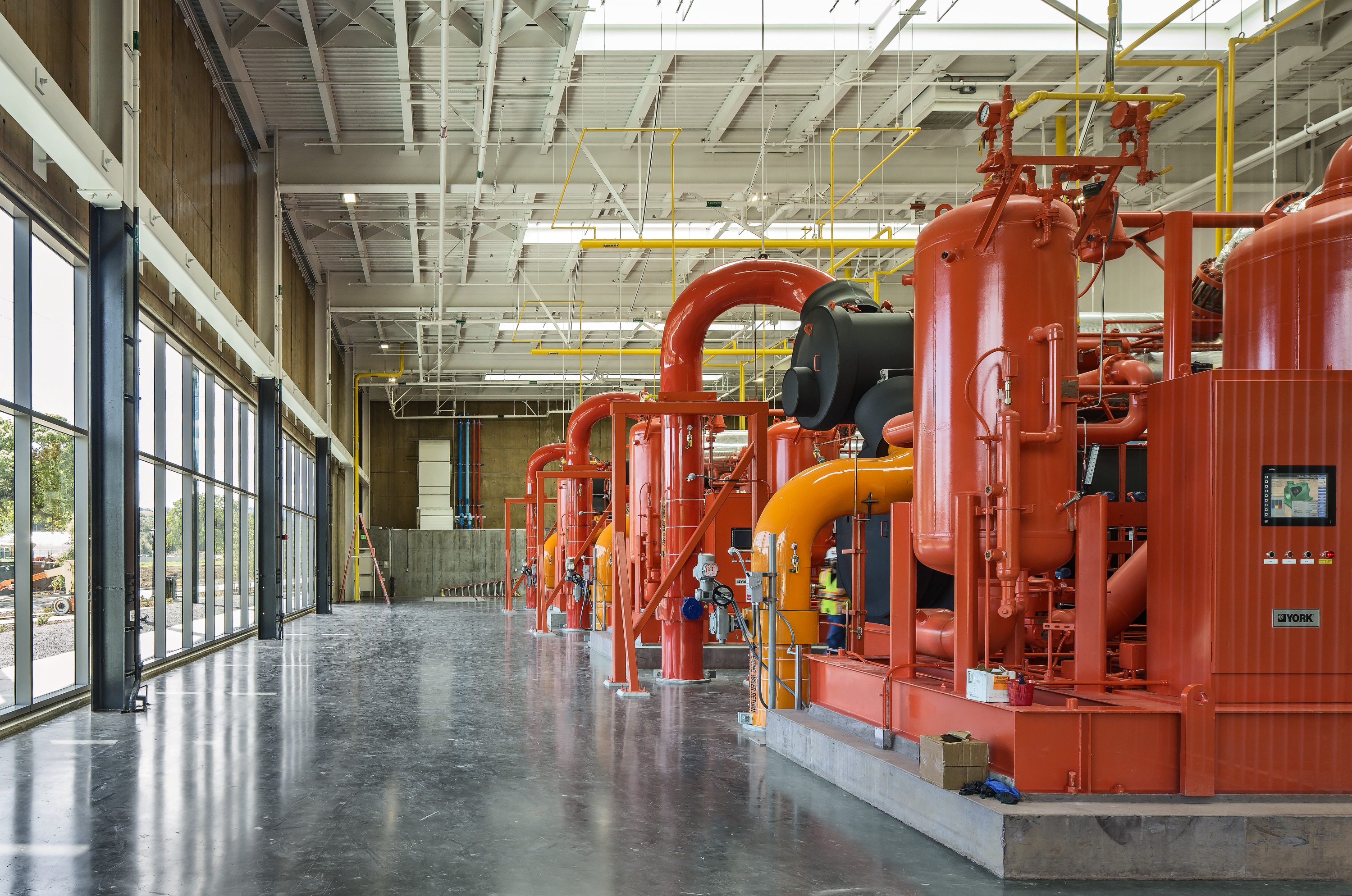Stanford Electrifies Its Campus, Cuts Greenhouse Gas Emissions by 65%
The Story In Brief
“Buildings are a big chunk of the challenge to develop sustainable, affordable energy for the world,” says Joe Stagner, executive director for sustainability and energy management at Stanford University. Stagner speaks with EPRI Journal about how Stanford’s new energy system works, the environmental and financial benefits, and its applicability in other settings, including his own house.
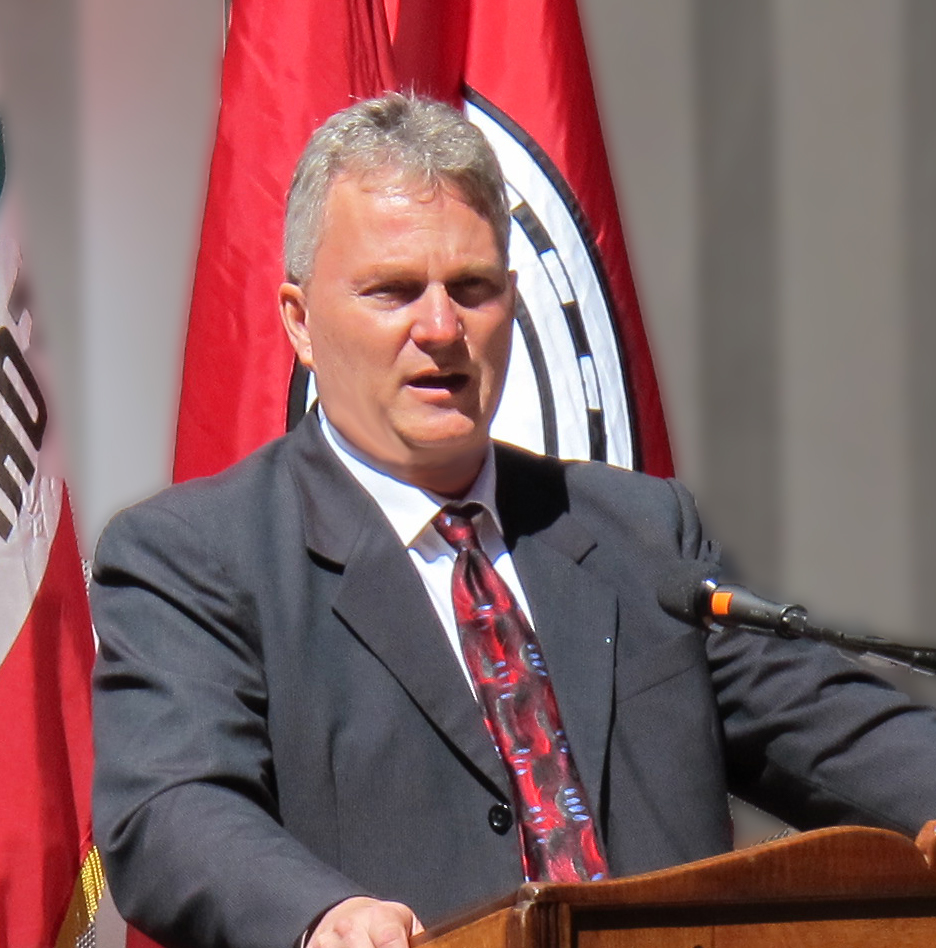
EJ: Describe Stanford’s energy supply system.
Stagner: Stanford previously powered its campus with a natural-gas-fired cogeneration plant. It heated buildings through a network of underground steam pipes and cooled buildings with cold water pipes. In 2015, we decommissioned the plant and converted the campus to a mostly electric energy supply system. An innovative aspect of the system is heat recovery to meet overlapping heating and cooling needs. Cooling the campus involves collecting waste heat from buildings and transporting it via underground chilled water pipes to a central energy facility. There, devices known as heat recovery chillers (also called heat pumps) transfer the waste heat to a new network of underground hot water pipes to heat buildings.
The central facility houses several large hot and cold water tanks that serve as thermal storage, enabling the system to time-shift cooling and heating. For example, if it’s hot in the daytime, you could save the extra heat and use it at night when it’s cold. When waste heat recovery from cooling processes is not sufficient to meet campus heating needs in winter, late fall, and early spring, the same heat recovery chillers can fill those gaps by extracting heat from the ground or Stanford’s lake water irrigation system. Control software operates all these components efficiently. For backup heating and cooling and to meet thermal loads not covered by the heat recovery process, we have conventional electric-powered chillers and natural-gas-fueled hot water generators.
Another important aspect of our energy system is clean electricity. Stanford signed 25-year power purchase agreements for new on- and off-campus solar projects to supply 53% of our electricity. The remainder comes from the California grid.
EJ: Why did Stanford electrify?
Stagner: According to the International Energy Agency, heating, cooling, and power in buildings consume about 40% of the developed world’s energy. So, buildings are a big chunk of the challenge to develop sustainable, affordable energy for the world. That’s the context for our energy system.
Many scientists believe that over the next few decades the only practical path to more sustainable energy is electrification across all sectors and supplying the electricity with a clean, economic, reliable, resilient, and open-access grid. That’s not just the finding of Stanford and why we built our system. It’s been verified by the International Energy Agency, United Nations Environment Program, and the national laboratories. Southern California Edison has arrived at a similar conclusion as well. In buildings—whether it’s the Stanford campus or a house—this means electrifying the power, heating, and cooling, each of which represents about a third of building energy use. The power component is already electric, and cooling is primarily electric.
The challenge is the heating and hot water components. Electric resistance heating is very inefficient, which is why many have moved to natural gas for heat. The key for heating and hot water in buildings is electric heat recovery chillers. They are five to six times more efficient than electric resistance heating and twice as efficient as using natural gas.
With heat recovery chillers as part of the building energy system, you can recover and reuse your waste heat from cooling and extract heat out of the ground or a water body. During summer in all climates across America, there’s a surplus of environmental heat, so there’s no reason to burn fossil fuel to generate more heat. You can use heat recovery chillers to provide 100% of heat and hot water needs. That may be only 4 or 5 months in Boston or 10 months in Phoenix.
- Miles of underground steam pipes converted to hot water pipes: 22
- Number of buildings upgraded to hot water pipes: 155
- Percentage of time during which campus heating and cooling demands overlap: 70%
- Percentage of waste heat recovered from cooling: 53% (Stanford’s previous natural-gas cogeneration system lost 100% of its waste heat)
- Percentage of campus heat load met by recovery of waste heat: 88%
- Percentage of Stanford’s electricity supplied by on- and off-campus solar projects: 53%
- Increase in overall energy efficiency relative to Stanford’s previous cogeneration system: 50%
- Reduction in greenhouse gas emissions relative to the previous cogeneration system: 65%
- Reduction in water use relative to the previous cogeneration system: 18%
- Increase in system efficiency as a result of the automated control software: 15%
- Capital cost: $485 million
- Projected savings relative to the costs of the previous cogeneration system: $420 million over 35 years
Source: Stanford University
In winter, particularly in northern areas like Boston, you hear people say, ‘It’s too cold for waste heat recovery.’ What they don’t understand is that even in cold regions there’s a small amount of waste heat available from cooling and humidity control in complex buildings. Our data shows that more than 50% of annual heating and hot water needs at two large universities in Illinois and Massachusetts can be met by deploying heat recovery chillers and recovering waste heat from existing cooling processes. Those same heat recovery chillers can also extract the other 50% of needed heat from the ground, lake, or ocean. We can therefore fully electrify heating and hot water supply for buildings.
EJ: How do the heat recovery and thermal storage work?
Stagner: We have a chilled water loop that cycles around campus continuously. The central energy facility delivers 42°F water to campus buildings through cold water pipes. At each building, heat exchangers use this cold water to provide cooling, and 56°F water is returned to the central facility. There, a heat recovery chiller cools it back down to 42°F and transfers the heat to a separate hot water circulating system. This continuously cycling loop delivers 160°F water to buildings to provide heat for space heating and hot water and returns 130°F water to the central energy facility where the heat recovery chiller reheats it to 160°F (see animation below).
Watch an animation about how Stanford’s heat recovery system works.
The thermal energy storage system consists of 70-foot-tall tanks of hot and cold water. The cold water tank has a pipe coming out the bottom to supply 42°F water to campus for cooling, simultaneously replacing it with 56°F water from campus through a pipe at the top. The hot water tank has a pipe coming out the top to deliver 160°F water to campus for heating and receives 130°F water back at the bottom. The large temperature difference between the top and bottom of the tanks creates a ‘thermocline’ that separates the warmer and colder water. Temperature probes placed every 1 foot from top to bottom indicate how much cold and hot water is available for campus heating and cooling (see animation below).
Watch an animation about how Stanford’s thermal storage system works.
Cold water storage saves money in three ways: It allows you to shift cooling to off-peak hours when electricity is cheaper; it’s less capital-intensive than deploying extra heat recovery chillers or regular electric chillers to meet peak loads; and its operations and maintenance costs are lower than heat pumps and chillers. Imagine that the daytime cooling load for a campus is 30,000 units, and the night cooling load is 10,000 units. Without cold water storage, you need to deploy and turn on 30,000 units of heat recovery chillers or regular electric chillers in the daytime and run 10,000 units at night. With cold water storage, you can install and run 20,000 units of heat recovery chillers or chillers 24 hours a day and store the 10,000 units of cooling not needed at night. In the day, when you need 30,000 units of chilling, you can borrow 10,000 units from storage to complement the 20,000 units of heat recovery chillers or chillers. A hot water storage system offers those same cost benefits for heating.
EJ: How does the control software work?
Stagner: Stanford developed a software program called the Central Energy Plant Optimization Model to prove the heat recovery concept and help with system design. Stanford commissioned Johnson Controls to develop an industrial version of this software that can be used for real-time operations and planning. The operational function is like an airplane autopilot, constantly seeking the best path forward, given constantly changing weather, heating and cooling loads, grid electricity prices, thermal energy storage balances, and many other factors. Every 15 minutes, it interrogates the thermal storage tanks to see how much usable hot and cold water they contain; determines which heat recovery chillers, chillers, and hot water generators are available and which are down for maintenance; and fetches the campus-area weather forecast from the National Weather Service. Based on all this information, it reforecasts the heating, cooling, and power loads and optimizes the use of heat recovery and thermal storage to meet loads and reduce electrical peaks. We’ve found that the software makes the entire system 15% more efficient than it would be if operated by humans.
We can use the software’s planning function to simulate operations in future years with differing loads. For example, if loads grow as a result of campus expansion, the software may tell us that we need to change or add more equipment.
EJ: What have been the environmental benefits?
Stagner: With our previous natural-gas cogeneration system, 100% of the waste heat from cooling the campus was thrown away in evaporative cooling towers. The new system’s heat recovery increased overall energy efficiency by 50%, which translates into a 50% reduction in campus greenhouse gas emissions. When factoring in the solar power purchase agreements that help power the system, our greenhouse gas reduction grows to 65%.
If we power campus with 100% clean electricity, we could achieve an 85% greenhouse gas reduction. The remaining 15% is a result of scattered natural gas and liquid fuel use in vehicles, emergency generators, and other campus equipment not served by our new energy system yet. While we want to be powered by 100% renewables eventually, for now we want to see how electricity markets and technologies evolve. For example, we may determine that we need more load-following generation or baseload renewables such as geothermal energy.
The new system also uses 18% less water than the cogeneration system, which consumed significant water as it rejected waste heat via evaporative cooling.
EJ: How about the financial benefits?
Stagner: The new system had a capital cost of $485 million. At the outset of the project, we calculated that it would save us about $420 million over 35 years, relative to the costs of our previous system.
The control software and thermal energy storage helped us to reduce our peak load and increase our load factor on the grid. This is contrary to conventional expectations when electrifying a load previously served by natural-gas-fired cogeneration. For example, when the cogeneration plant was offline for maintenance, we’d pull a peak of 46 megawatts from the grid to run our campus. Now that we’re electric, our peak is down to 38 megawatts.
A recent audit found that we’re 10% under the original cost estimates for the system. This is mainly a result of two factors: our low-cost solar power purchase agreements and our ability to purchase California grid electricity through ‘direct access.’
EJ: To what extent can Stanford’s approach be applied in residential and commercial buildings?
Stagner: Even though Stanford has a district energy system with complex buildings, the insights are applicable in many types of buildings all the way down to the residential level. Heat recovery and heat recovery chillers can be used at many scales. I am considering doing what we did at Stanford at the next house I design when I retire and move. I said, ‘If I’m going to design a house, would it be practical to have both hot and cold thermal storage and model the system with predictive software?’ Instead of burning natural gas, I could use the waste heat from the air conditioning to produce the hot water that my kid’s using in the shower or my wife’s using in the washer. It turns out the answer is, ‘Yes, this can be done.’
Many houses have hot water tanks, which can serve as hot thermal storage. Cold water storage tanks may or may not be needed depending on the house’s load profile. Heat recovery chillers like the ones we installed at Stanford are commercially available for houses. They’re called ‘triple-function geothermal heat pumps’ and ‘reverse cycle chillers,’ depending on whether they extract heat from the ground or air. They can recover waste heat from your air conditioning in summer to make 140°F hot water for your house. They also can extract heat from the air or ground whenever you are not running the air conditioning. Control software similar to Stanford’s can be used to optimize heat storage and use.
However, research is needed to apply this solution and develop software at different scales. Residential and commercial demonstrations would be great, and several building projects in North America are considering this approach. EPRI could model what an electrified America would look like and cost over the next 50 or 100 years. We also need more education to inform the public of these new opportunities, as well as development and dissemination of heat pump and other technologies. Research on new cooling fluids or compression methods to increase the efficiency of heat pumps and heat recovery chillers could lower the costs of electrification even further.
EJ: Stanford’s campus is similar to a small city. What lessons can cities draw?
Stagner: While you can apply this approach in individual homes and commercial buildings, it’s enhanced if you apply it in district energy systems. Any time you collect a series of buildings together you get more efficiencies. You get better thermal balance and more ways to recover waste heat from buildings for use in other buildings. In Europe, there are many good examples of cities that use district heating. Hot and cold water for district heating and cooling can be part of the basic city infrastructure just like natural gas, water, sewer, storm drainage, and communications.
EJ: What can utilities and regulators do to facilitate electrification?
Stagner: To make electrification work, you need clean power. Once you have that, natural gas is no longer a greenhouse gas reduction strategy. Is a clean grid economically competitive with natural gas distributed to buildings? It probably will be long term. We modeled a new cogeneration plant powered by cheap natural gas for the next 30 years and compared it to an all-electric scenario with electricity at more than 10 cents per kilowatt-hour, and electric won out. With our power purchase agreements, we locked in solar power for 5 cents per kilowatt-hour for 25 years, helping our system outcompete cogeneration by an even wider margin.
Utilities and regulators need to set in motion a long-term plan to electrify everything by enabling widespread use of local and grid-scale renewable energy and by providing grid infrastructure including robust transmission systems, thermal and electricity storage, grid-scale system management software, and regulatory rules and electricity tariffs to incentivize electrification.
Artwork and animations by Matthew Oakley


